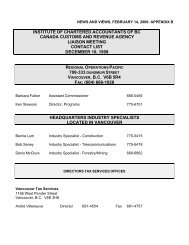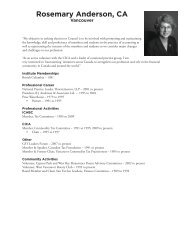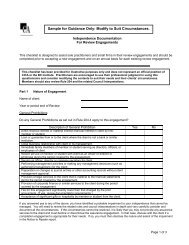CICA 20 QUESTIONS Strategy - Institute of Chartered Accountants ...
CICA 20 QUESTIONS Strategy - Institute of Chartered Accountants ...
CICA 20 QUESTIONS Strategy - Institute of Chartered Accountants ...
- No tags were found...
You also want an ePaper? Increase the reach of your titles
YUMPU automatically turns print PDFs into web optimized ePapers that Google loves.
grounded in reality. Directors, therefore, need to ensure that thestrategic plan indicates the basis upon which the needs <strong>of</strong> eachstakeholder group were identified and selected (e.g.customer/employee surveys; comparative competitive positioning;benchmarking studies, etc.)Finally (as with the case <strong>of</strong> the organization’s vision), missionstatements, which are explicit, clear and widely shared have beenshown to have a powerful and positive impact on internal stakeholder(employee) behavior.Accordingly, directors need to that awareness,understanding and acceptance <strong>of</strong> the mission exists throughout theorganization.14. Does the strategy have a proper statement <strong>of</strong> values?For an organization, it is important that the actions and behaviors <strong>of</strong>its employees – in striving to maximize shareholder value and achieveperformance targets - can withstand the test <strong>of</strong> public scrutiny.Valuesconstitute the internal ethical and cultural priorities (e.g., honesty,mutual respect, transparency, innovation, teamwork, etc.) that shape theway in which people behave and make decisions.When widely shared,they enhance especially an organization’s ability to focus employeebehavior. Directors, therefore, need to make sure that theirorganization’s strategy contains a statement <strong>of</strong> values which theyconsider important for the harmonious and ethical running <strong>of</strong> theiroperations. Organizations can then use their ‘statements <strong>of</strong> values’and ‘codes <strong>of</strong> conduct’ as vehicles for attracting the right stakeholdersto them.One notable example <strong>of</strong> an aspirational vision occurred in the early 1960s when USPresident John Kennedy challenged NASA to: (sic) ‘land a man on the surface <strong>of</strong> the moonand return him safely back to earth before the end <strong>of</strong> the decade’. Apparently, few personsin NASA actually believed that it could be done because it involved so many newtechnologies which had yet to be invented. Nevertheless, Kennedy’s vision made thescientists at the space agency excited about the prospects <strong>of</strong> actually making it happen‘during their watch’ and, <strong>of</strong> course, they eventually fulfilled it.6
















